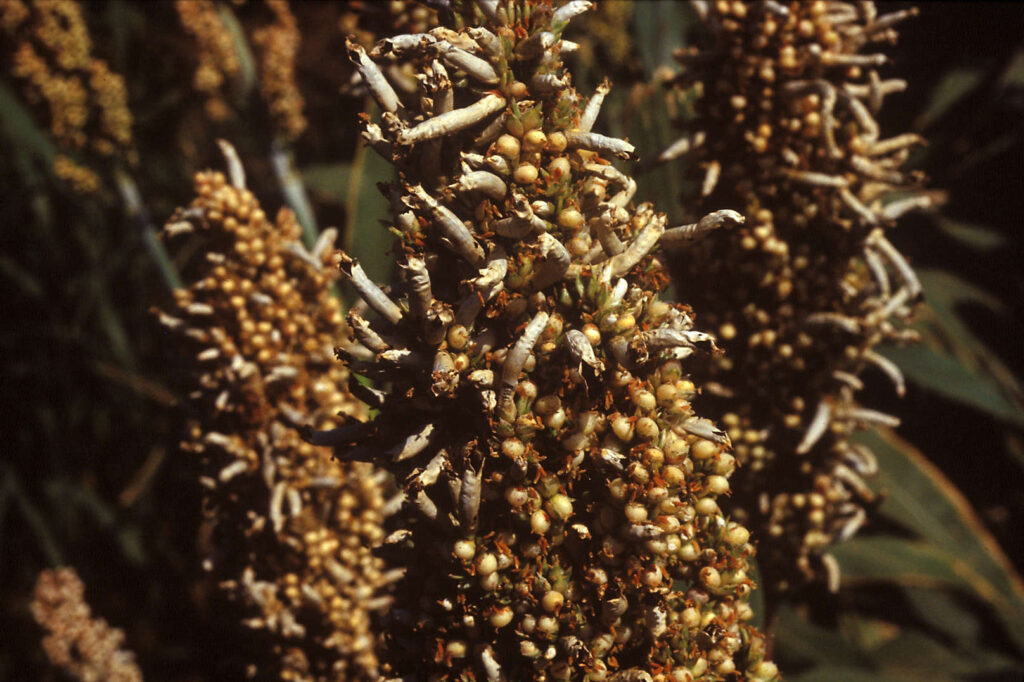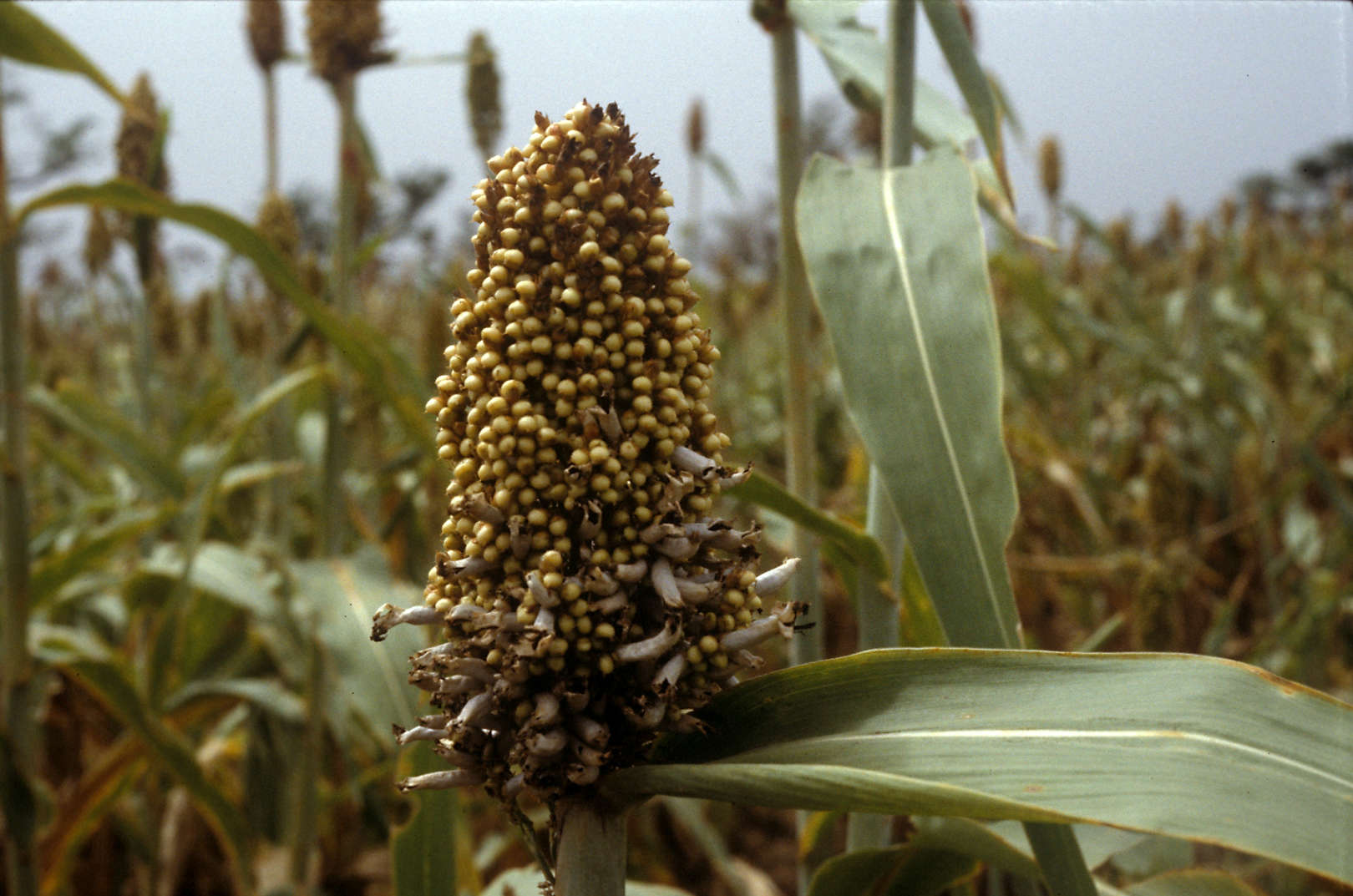“Long Smut of Sorghum” is a type of plant disease that affects sorghum plants. Sorghum is a type of cereal grain that’s often grown for its seeds, which can be used for food, animal feed, and other purposes. However, just like humans can get sick, plants can also get diseases caused by tiny organisms called fungi.
The first account of the extended plant disease in sorghum, known as “long smut of sorghum caused by Tolyposporium filiferum Busse,” was documented by Busse in 1904. This occurred in East Africa. This fungus enters the sorghum plant and starts growing inside it. As it grows, it forms a kind of mass or lump that looks unusual on the plant. This lump can release spores, which are like tiny seeds for the fungus. These spores can spread to other sorghum plants, making them sick too.
Symptoms of Long Smut of Sorghum

Long Smut of Sorghum is a plant disease that has certain noticeable signs. Here’s how you can identify it:
- Limited Area Affected: The disease doesn’t usually infect the entire plant but is limited to a small part called the florets. These florets change into something called “smut sori,” which are scattered on the plant’s head.
- Distinctive Shape: These smut sori have a special shape. They are elongated and sort of like cylinders, with a slight curve. They’re not round like normal parts of the plant.
- Texture and Color: These sori have a covering that looks a bit like a thin layer. It’s creamy-brown and thick compared to the rest of the plant. This covering gives them a distinctive appearance.
- Spreading Spores: At the top part of each sorus, it splits open. This lets out a black mass that contains spores. These spores are like tiny seeds for the fungus. When the sorus splits, the spores can be carried by the wind to other plants, spreading the disease.
- Remaining Filaments: Inside each sorus, you can find about 8 to 10 dark brown filaments. These filaments used to be part of the plant’s floral tissues. They now remain as a part of the structure where the spores are.
- Different from Normal: The sori caused by Long Smut are longer than what you’d normally see on the plant. They’re about 2 to 4 centimeters long. And unlike other types of smut, they aren’t evenly spread out on the plant’s head.
- Membrane Burst: When the time is right, the thin covering membrane of the sori breaks open. This lets out a powdery black mass. These tiny balls are the spores that can start the disease in other plants.
Management of Long Smut of Sorghum
Preventing Method:
Izumonas-Best Fungicide
Contents: Pseudomonas Fluorescens
IZUMONAS is a biological product consisting of plant growth-promoting rhizobacteria (PGPR), which are naturally occurring bacteria found widely in nature. This unique product is designed to enhance plant defence mechanisms and promote healthy growth. IZUMONAS can be used on all types of crops without leaving any residue on the plants.
Izumil-Best Fungicide
Contents:
- Extract of Streptomyces griseus: 30%
- Extract of Streptomyces violaceus: 40%
- Dissolving agents: 30%
IZUMIL is a remarkable biotech research product that has been developed to activate the natural defence mechanism of plants. By using IZUMIL, plants can better protect themselves against fungal pathogens, improve their physiological functions, and develop resistance against various harmful microorganisms. Similar to IZUMONAS, IZUMIL can be safely used on all crops without leaving any residue.
Modes of Use:
- Seed Treatment: Mix 5-10 ml of IZUMONAS and IZUMIL per kilogram of seeds in an adequate amount of water. Submerge the seeds in this solution and allow them to dry in a shaded area before sowing.
- Seedling Treatment: Combine 100 ml of IZUMONAS and IZUMIL per 20 litres of water. Dip the roots of the seedlings in this solution for approximately 30 minutes prior to transplanting.
- Soil Application: Mix 500 ml of IZUMONAS and IZUMIL with 30 kilograms of farmyard manure (FYM) or soil. Apply this mixture to one acre of land before ploughing or irrigation.
- Foliar Application: Dilute 2-3 ml of IZUMONAS and IZUMIL each in 1 litre of water. Use this solution to spray the entire foliage of the plants, ensuring complete coverage on both sides of the leaves. It is advisable to shake the bottle before use. For best results, spray early in the morning or evening. If a power sprayer is used, double the recommended dosage.
Cultural Method:
Seed treatment: Treat sorghum seeds with fungicides before planting to eliminate or reduce the presence of the pathogen.
- Use disease-free seeds.
- Follow crop rotation.
- Collect the smutted ear heads in cloth bags and bury them in the soil.

